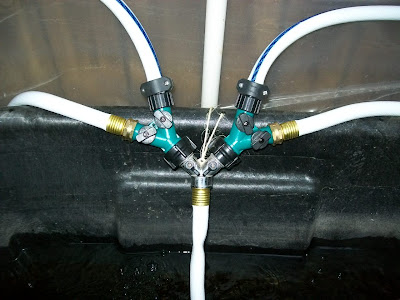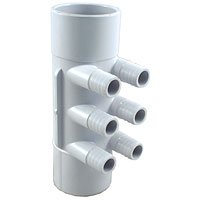
I was stymied about how I was going to carry the water from my 1000 gph pump back to my four growbeds. Id looked into 1" no-kink pond tubing and associated fittings/valves, but the tally was getting pretty pricey.
When I was first plumbing the 1000 gph pump in for just 2 growbeds, I figured garden hose might work - and if I was wrong, I would only be out the price of a single length of hose and a single splitter (with built-in ball valves). Garden hose ended up working fine for just two growbeds.
I still wasnt sure garden hose would work for the full-up system, particularly with the long (23) lengths needed to reach each of the two growbeds on the opposite side of the greenhouse from the sump. But I was willing to try. Turns out garden hose works like a charm. I even have to throttle the flow just a tad.
Youll want to get hose that is safe to use for drinking water, because regular hose can leach lead into the water. This set-up requires 60 feet of hose, so you could either get a single 75-foot hose (~$40 via Home Depot, search "lead-free hose") or two 50-foot hoses (~$23 each via Home Depot, search "neverkink boat hose"). You can get free shipping if your total order is over $50, assuming your local store doesnt have these hoses in stock.

In watching Murray Hallams "Aquaponics: The First 12 Months," I saw his contraption for automatically adding water when the tank gets low - like the ballcock older toilets use to shut off flow into the bowl when its full of water after a flush. He had his hooked to the home-owners water spigot. My only trouble was I couldnt find the exact configuration at my local hardware store, and googling ballcock with my computers kid-friendly browser settings made finding anything online even harder.
Since I currently have goldfish in the sump, and plan to use the sump for small fish, I dont want my sump to run dry. Even if I couldnt find the exact contraption Murray uses.
I came up with the idea of a water reservoir, like a water cooler. I use the standard 5-gallon bottles to do this. I cut the neck off the bottom bottle and drilled 1" holes into the sides to allow tank water in.
Next I add 1/2 teaspoon of Amquel to an empty 5-gallon bottle, then fill with tap water. The Amquel removes chlorine and other nasty stuff from the tap water.
Finally I invert the regular 5-gallon bottle and rest it in the top in the modified bottle.
As the water in the system evaporates, the water in the 5-gallon reservoir glugs out, bit by bit. I anticipate this will make adding water a weekly chore and eliminate risk that my sump runs dry without me noticing.

I dont have kids that could/would drown in 20" of water, but Kiddie Covers make the fish happier. Bluegill, at least, dont like to be without cover (fear of predators that might scoop them out). Plus bluegill are known for jumping out of the tank (lost one myself that way).
I just used cheap 1x3 for the covers, supported by frames made of inexpensive 2x3. This picture showed in this post has a close up of the more complicated sump tank lide, which has a cut-out for the 5-gallon reservoir.
Finally, below is a link to some video footage I shot today. The first video is really long (over 12 minutes) showing how the kiddie covers work, feeding fish, how the CHOP plumbing works, the final bell siphon design, and the top-up tank.
The second video is 3 minutes long and explains how I plumb the water to the growbeds on the opposite side of the greenhose (and talks about my solar oven).














































